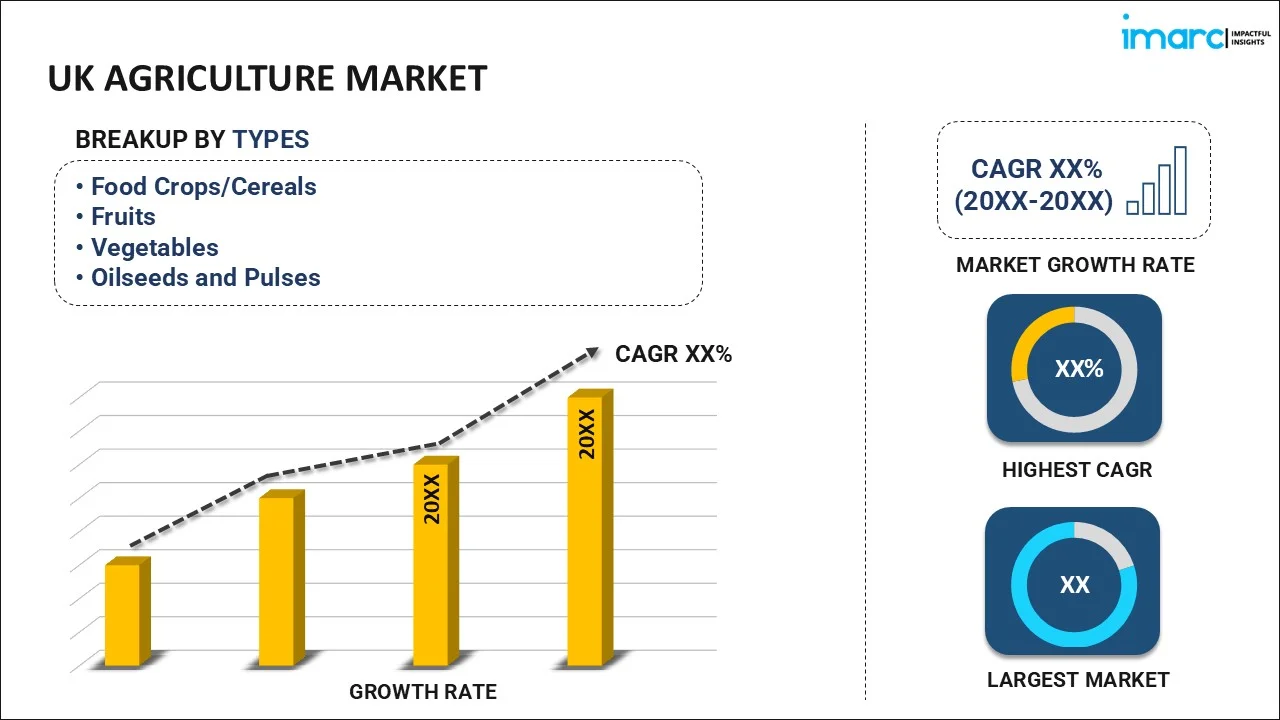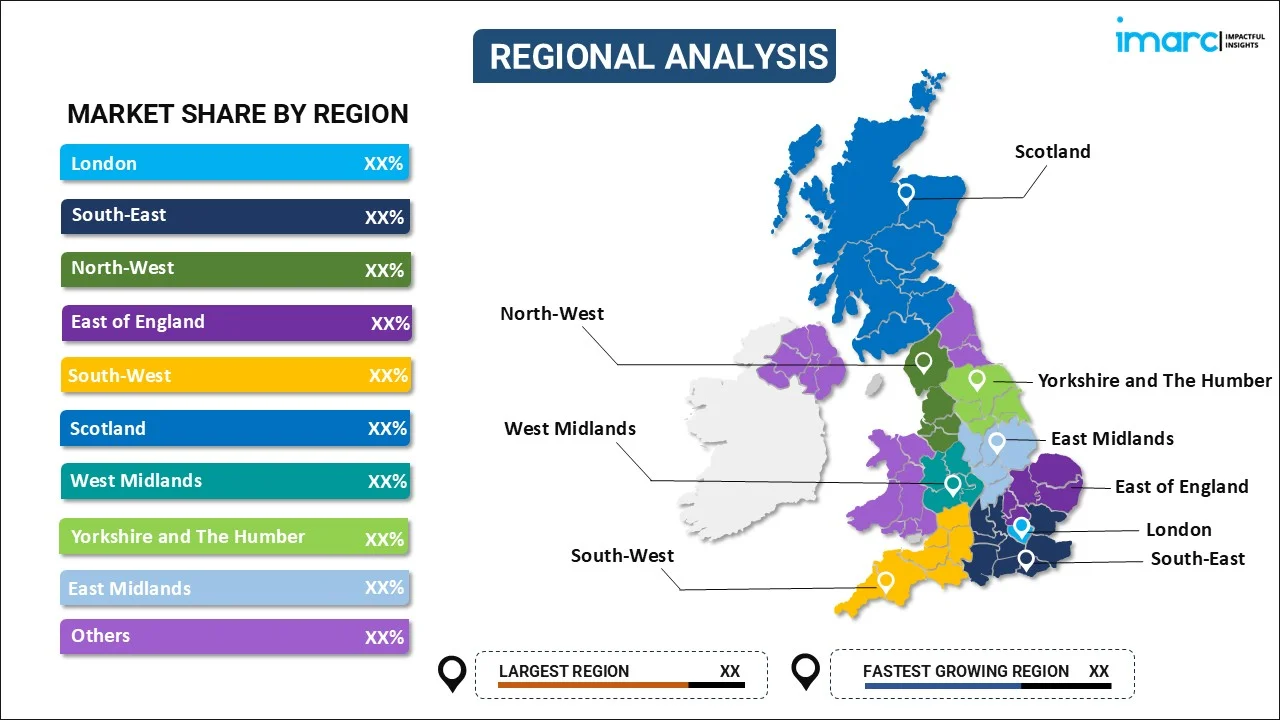
UK Agriculture Market Report by Type (Food Crops/Cereals, Fruits, Vegetables, Oilseeds and Pulses), and Region 2025-2033
UK Agriculture Market Overview:
The UK agriculture market size reached USD 44.14 Billion in 2024. Looking forward, IMARC Group expects the market to reach USD 70.26 Billion by 2033, exhibiting a growth rate (CAGR) of 4.80% during 2025-2033. The market is witnessing rapid growth, driven by the imposition of several government policies, ongoing technological advancements, shifting consumer demand and preferences for organic and locally sourced products, and the rising popularity of agri-tech startups.
|
Report Attribute
|
Key Statistics
|
|---|---|
|
Base Year
|
2024
|
|
Forecast Years
|
2025-2033
|
|
Historical Years
|
2019-2024
|
| Market Size in 2024 | USD 44.14 Billion |
| Market Forecast in 2033 | USD 70.26 Billion |
| Market Growth Rate 2025-2033 | 4.80% |
UK Agriculture Market Trends:
Imposition of Government Policies and Subsidies
The introduction of an Environmental Land Management scheme (ELMS) that emphasizes sustainability and environmental conservation is boosting the UK agriculture market growth. Moreover, the implementation of subsidies that help to ensure that farmers continue to produce food while meeting environmental goals is favoring the market expansion. Besides this, the establishment of several trade agreements, tariffs, and minimum wage laws, is positively influencing the market growth. Moreover, the country’s emphasis on reducing carbon emissions and adapting to climate change is creating a positive outlook for the market. Along with this, the transition to low-carbon agriculture, driven by government policies, which encourage practices such as carbon sequestration, reduced use of fossil fuels, and adoption of renewable energy sources on farms, is bolstering the expansion of the market.
Rapid Technological Innovations in Agriculture
The burgeoning integration of technology in UK agriculture is another major driver boosting the industry growth. The introduction of precision farming, automation, and the use of data-driven decision-making tools that transform the traditional farming practices is catalyzing the market growth. Precision agriculture allows farmers to monitor soil health, moisture levels, crop growth, and pest activity more accurately. Along with this, drones, global positioning system (GPS) systems, and remote sensors that enable farmers to gather real-time data, which improves yield forecasting, resource management, and crop monitoring, are acting as growth-inducing factors. In addition to this, automation and robotics are increasingly utilized to address labor shortages, particularly for harvesting and planting.
Changing Consumer Preferences and Demand
There is growing demand for organic, free-range, and sustainably-produced food, bolstering the market growth. In line with this, consumers are prioritizing ethical and environmental considerations when making food choices, thereby influencing the crops and livestock types that farmers produce. Along with this, the heightened adoption of plant-based diets and the rise of vegetarianism and veganism are fueling the market growth. Moreover, the increasing demand for alternative proteins, such as pulses, legumes, and plant-based meat substitutes, as consumers move away from animal products, thereby encouraging farmers to diversify their crops, is boosting the market growth. In addition to this, the growing concerns about food security, as consumers demand locally-grown fruits, vegetables, and meat, are stimulating the market growth.
UK Agriculture Market News:
- In February 2024, Unilever launched its first regenerative agriculture project in the UK, working with farms that grow mustard seeds and mint leaves used in Colman’s products.
- In August 2024, Yara UK and PepsiCo Europe announced a long-term partnership to lower the carbon footprint of food production by providing farmers with industry-leading crop nutrition products and digital solutions. They adopted sustainable agriculture practices across approximately 1,000 farms spanning 128,000 hectares across the EU and UK. Yara will hand over up to 165,000 tons of fertilizer annually to PepsiCo to meet around 25% of their crop fertilizer needs in Europe by 2030.
UK Agriculture Market Segmentation:
IMARC Group provides an analysis of the key trends in each segment of the market, along with forecasts at the country level for 2025-2033. Our report has categorized the market based on type.
Type Insights:

- Food Crops/Cereals
- Fruits
- Vegetables
- Oilseeds and Pulses
The report has provided a detailed breakup and analysis of the market based on the type. This includes food crops/cereals, fruits, vegetables, and oilseeds and pulses.
Regional Insights:

- London
- South East
- North West
- East of England
- South West
- Scotland
- West Midlands
- Yorkshire and The Humber
- East Midlands
- Others
The report has also provided a comprehensive analysis of all the major regional markets, which include London, South East, North West, East of England, South West, Scotland, West Midlands, Yorkshire and The Humber, East Midlands, and Others.
Competitive Landscape:
The market research report has also provided a comprehensive analysis of the competitive landscape in the market. Competitive analysis such as market structure, key player positioning, top winning strategies, competitive dashboard, and company evaluation quadrant has been covered in the report. Also, detailed profiles of all major companies have been provided.
UK Agriculture Market Report Coverage:
| Report Features | Details |
|---|---|
| Base Year of the Analysis | 2024 |
| Historical Period | 2019-2024 |
| Forecast Period | 2025-2033 |
| Units | USD Billion |
| Scope of the Report | Exploration of Historical Trends and Market Outlook, Industry Catalysts and Challenges, Segment-Wise Historical and Future Market Assessment:
|
| Types Covered | Food Crops/Cereals, Fruits, Vegetables, Oilseeds and Pulses |
| Regions Covered | London, South East, North West, East of England, South West, Scotland, West Midlands, Yorkshire and The Humber, East Midlands, Others |
| Customization Scope | 10% Free Customization |
| Post-Sale Analyst Support | 10-12 Weeks |
| Delivery Format | PDF and Excel through Email (We can also provide the editable version of the report in PPT/Word format on special request) |
Key Questions Answered in This Report:
- How has the UK agriculture market performed so far and how will it perform in the coming years?
- What has been the impact of COVID-19 on the UK agriculture market?
- What is the breakup of the UK agriculture market on the basis of type?
- What are the various stages in the value chain of the UK agriculture market?
- What are the key driving factors and challenges in the UK agriculture?
- What is the structure of the UK agriculture market and who are the key players?
- What is the degree of competition in the UK agriculture market?
Key Benefits for Stakeholders:
- IMARC’s industry report offers a comprehensive quantitative analysis of various market segments, historical and current market trends, market forecasts, and dynamics of the UK agriculture market from 2019-2033.
- The research report provides the latest information on the market drivers, challenges, and opportunities in the UK agriculture market.
- Porter's five forces analysis assist stakeholders in assessing the impact of new entrants, competitive rivalry, supplier power, buyer power, and the threat of substitution. It helps stakeholders to analyze the level of competition within the UK agriculture industry and its attractiveness.
- Competitive landscape allows stakeholders to understand their competitive environment and provides an insight into the current positions of key players in the market.
Need more help?
- Speak to our experienced analysts for insights on the current market scenarios.
- Include additional segments and countries to customize the report as per your requirement.
- Gain an unparalleled competitive advantage in your domain by understanding how to utilize the report and positively impacting your operations and revenue.
- For further assistance, please connect with our analysts.
 Inquire Before Buying
Inquire Before Buying
 Speak to an Analyst
Speak to an Analyst
 Request Brochure
Request Brochure
 Request Customization
Request Customization




.webp)




.webp)












